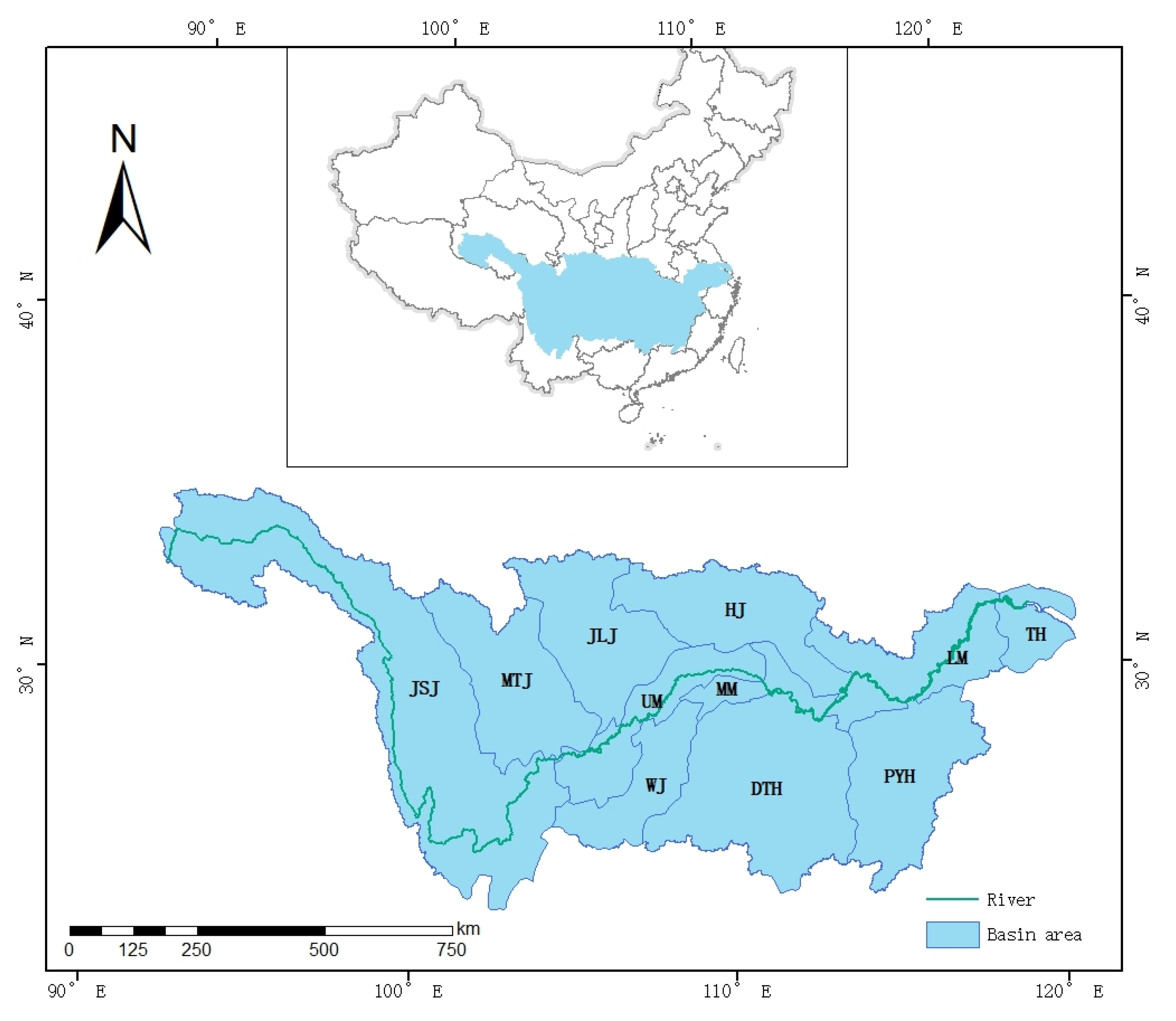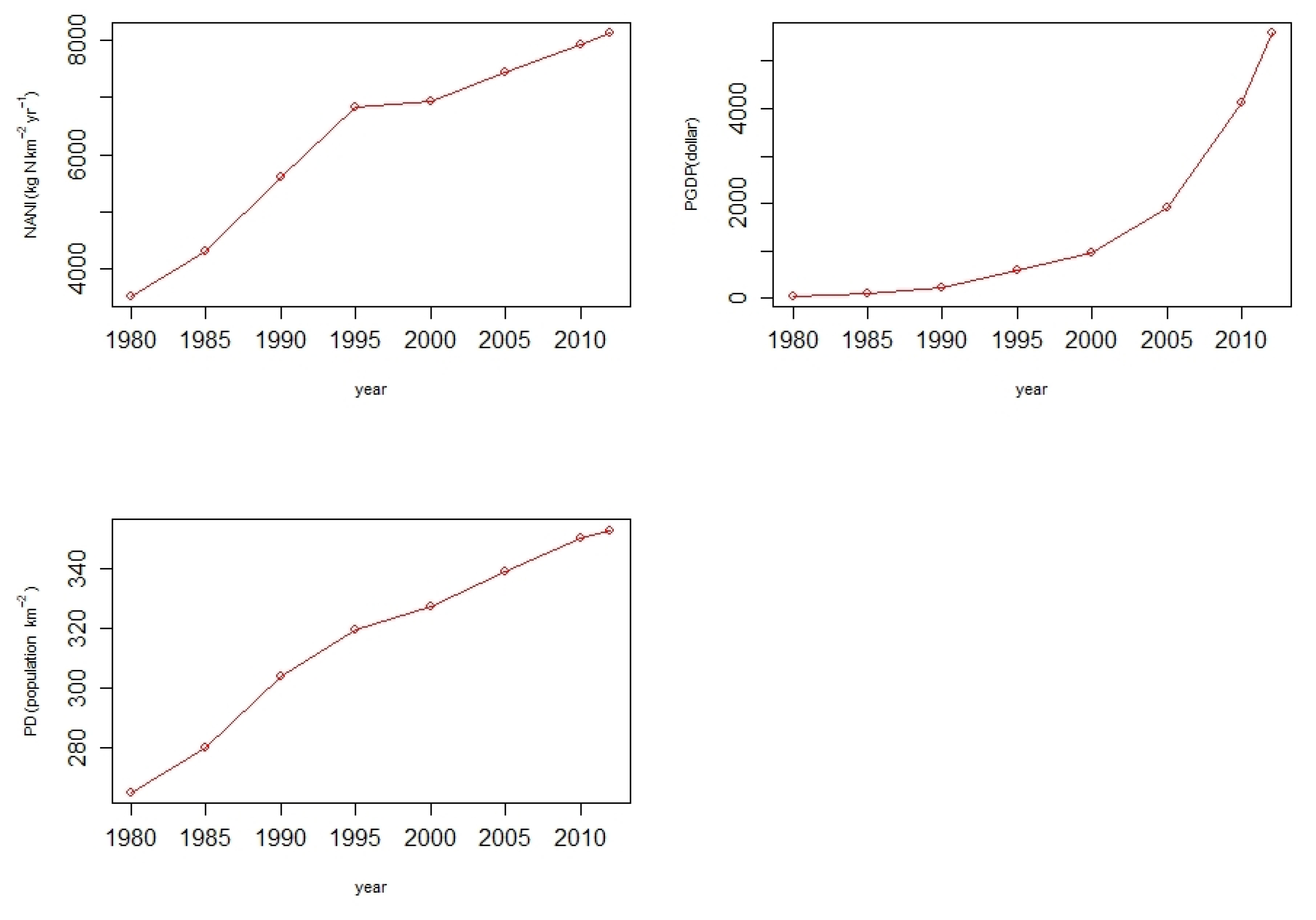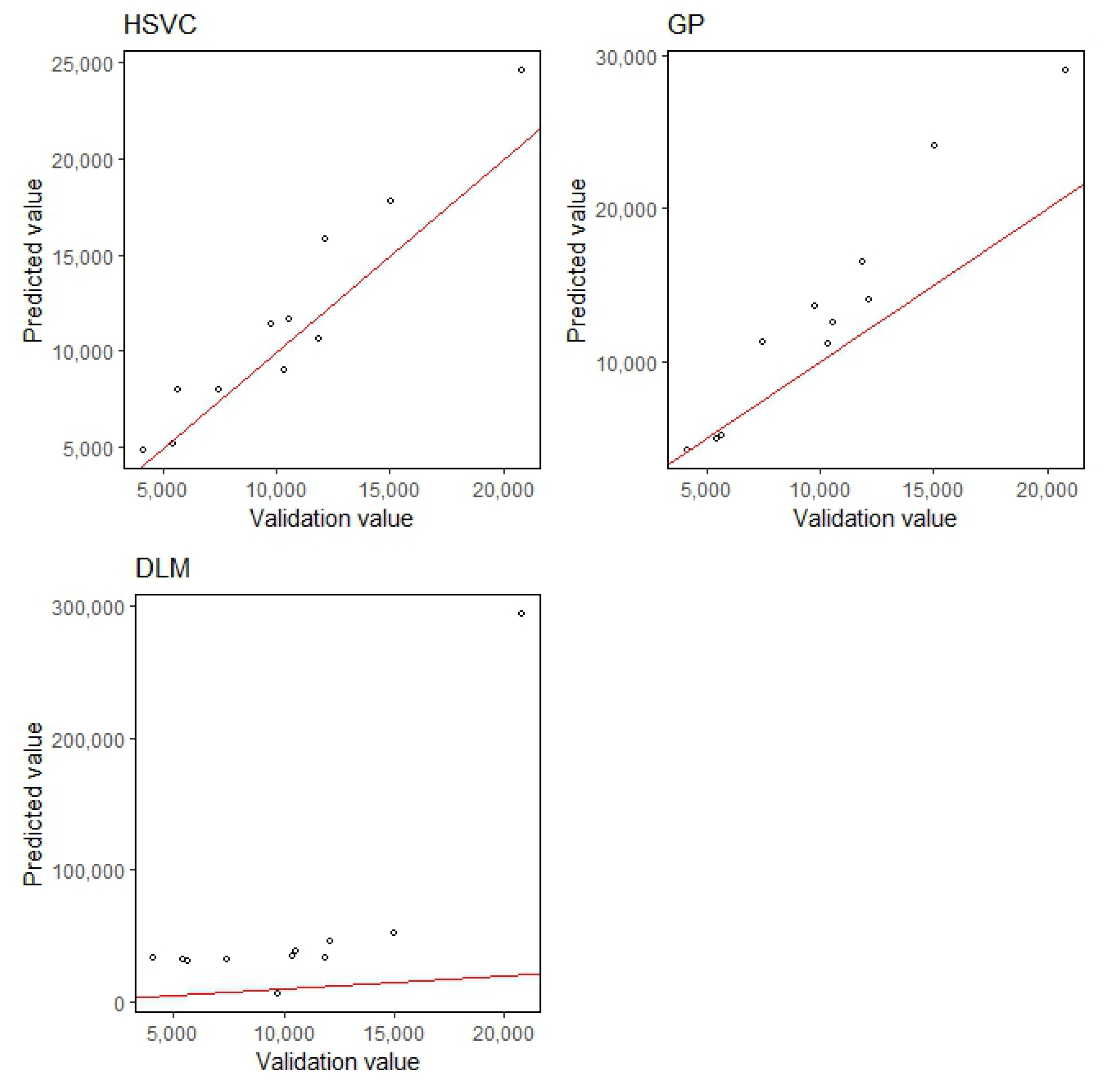Hierarchical Spatially Varying Coefficient Process Regression for Modeling Net Anthropogenic Nitrogen Inputs (NANI) from the Watershed of the Yangtze River, China
Abstract
:1. Introduction
2. Study Area and Data Sources
3. Methods
3.1. Hierarchical Spatially Varying Coefficient Process Regression
3.2. Temporal Forecasting and Model Assessment
3.3. Spatial Correlation Test
4. Results
4.1. Exploratory Analysis of Spatiotemporal Availability and Variability of the Observations
4.2. Model Fitting Based on Hierarchical Spatially Varying Coefficient Process Model
4.3. Forecasting Based on the Hierarchical Spatially Varying Coefficient Process Model
5. Discussion
5.1. Characteristics of the Predictor Variables
5.2. Limitations and Future Research
5.3. Implications for Watershed Nitrogen Management
6. Conclusions
Author Contributions
Funding
Institutional Review Board Statement
Informed Consent Statement
Data Availability Statement
Conflicts of Interest
References
- Yu, C.; Huang, X.; Chen, H.; Godfray, H.C.J.; Wright, J.S.; Hall, J.W.; Gong, P.; Ni, S.; Qiao, S.; Huang, G.; et al. Managing nitrogen to restore water quality in China. Nature 2019, 567, 516–520. [Google Scholar] [CrossRef] [PubMed]
- Han, Y.; Feng, G.; Swaney, D.; Dentener, F.; Koeble, R.; Ouyang, Y.; Gao, W. Global and regional estimation of net anthropogenic nitrogen inputs (NANI). Geoderma 2020, 361, 114066. [Google Scholar] [CrossRef]
- Pei, W.; Yan, T.; Lei, Q.; Zhang, T.; Fan, B.; Du, X.; Luo, J.; Stuart, L.; Liu, H. Spatio-temporal variation of net anthropogenic nitrogen inputs (NANI) from 1991 to 2019 and its impacts analysis from parameters in Northwest China. J. Environ. Manag. 2022, 321, 115996. [Google Scholar] [CrossRef] [PubMed]
- Wang, H.; Wu, Z.; Guo, X.; Di, D.; Jiang, M. Management implications of spatial–temporal variations of net anthropogenic nitrogen inputs (NANI) in the Yellow River Basin. Environ. Sci. Pollut. Res. 2022, 29, 52317–52335. [Google Scholar] [CrossRef]
- Yan, T.; Bai, J.; Bao, H.; Lei, Q.; Du, X.; Zhai, L.; Liu, H. Net Anthropogenic Nitrogen Input and Its Relationship with Riverine Nitrogen Flux in a Typical Irrigated Area of China Based on an Improved NANI Budgeting Model. Water 2023, 15, 276. [Google Scholar] [CrossRef]
- Gao, W.; Duan, Z.; Yan, C.; Liu, C. Influence of nutrient mitigation measures on the fractional export of watershed inputs in an urban watershed. Environ. Sci. Pollut. Res. 2020, 27, 1–9. [Google Scholar] [CrossRef] [PubMed]
- Liu, X.; Duan, L.; Mo, J.; Du, E.; Shen, J.; Lu, X.; Zhang, Y.; Zhou, X.; He, C.; Zhang, F. Nitrogen deposition and its ecological impact in China: An overview. Environ. Pollut. 2011, 159, 2251–2264. [Google Scholar] [CrossRef] [PubMed]
- Chen, F.; Hou, L.; Liu, M.; Zheng, Y.; Yin, G.; Lin, X.; Li, X.; Zong, H.; Deng, F.; Gao, J.; et al. Net anthropogenic nitrogen inputs (NANI) into the Yangtze River basin and the relationship with riverine nitrogen export. J. Geophys. Res. Biogeosci. 2016, 121, 451–465. [Google Scholar] [CrossRef]
- Gao, W.; Howarth, R.W.; Swaney, D.; Hong, B.; Guo, H. Enhanced N input to Lake Dianchi Basin from 1980 to 2010: Drivers and consequences. Sci. Total Environ. 2015, 505, 376–384. [Google Scholar] [CrossRef]
- Ti, C.; Pan, J.; Xia, Y.; Yan, X. A nitrogen budget of mainland China with spatial and temporal variation. Biogeochemistry 2012, 108, 381–394. [Google Scholar] [CrossRef]
- Yang, Y.; Gao, B.; Hao, H.; Zhou, H.; Lu, J. Nitrogen and phosphorus in sediments in China: A national-scale assessment and review. Sci. Total Environ. 2017, 576, 840–849. [Google Scholar] [CrossRef] [PubMed]
- Huang, H.; Chen, D.; Zhang, B.; Zeng, L.; Dahlgren, R.A. Modeling and forecasting riverine dissolved inorganic nitrogen export using anthropogenic nitrogen inputs, hydroclimate, and land-use change. J. Hydrol. 2014, 517, 95–104. [Google Scholar] [CrossRef]
- Chen, F.; Jia, G.; Chen, J. Nitrate sources and watershed denitrification inferred from nitrate dual isotopes in the Beijiang River, south China. Biogeochemistry 2009, 94, 163–174. [Google Scholar] [CrossRef]
- Gu, B.; Ge, Y.; Ren, Y.; Xu, B.; Luo, W.; Jiang, H.; Gu, B.; Chang, J. Atmospheric reactive nitrogen in China: Sources, recent trends, and damage costs. Environ. Sci. Technol. 2012, 46, 9420–9427. [Google Scholar] [CrossRef] [PubMed]
- Deng, C.; Liu, L.; Peng, D.; Li, H.; Zhao, Z.; Lyu, C.; Zhang, Z. Net anthropogenic nitrogen and phosphorus inputs in the Yangtze River economic belt: Spatiotemporal dynamics, attribution analysis, and diversity management. J. Hydrol. 2021, 597, 126221. [Google Scholar] [CrossRef]
- Zhang, W.; Su, J.; Du, X.; Li, X. Net anthropogenic nitrogen input to Huaihe River Basin, China during 1990-2010. Chin. J. Appl. Ecol. 2015, 26, 1831–1839. [Google Scholar]
- Howarth, R.W.; Billen, G.; Swaney, D.; Townsend, A.; Zhu, Z. Regional nitrogen budgets and riverine N & P fluxes for the drainages to the North Atlantic Ocean: Natural and human influences. Biogeochemistry 1996, 35, 75–139. [Google Scholar] [CrossRef]
- Hong, B.; Swaney, D.; Howarth, R.W. Estimating net anthropogenic nitrogen inputs to US watersheds: Comparison of methodologies. Environ. Sci. Technol. 2013, 47, 5199–5207. [Google Scholar] [CrossRef]
- Hong, B.; Swaney, D.; Mörth, C.M.; Smedberg, E.; Hägg, H.E.; Humborg, C.; Howarth, R.W.; Bouraoui, F. Evaluating regional variation of net anthropogenic nitrogen and phosphorus inputs (NANI/NAPI), major drivers, nutrient retention pattern and management implications in the multinational areas of Baltic Sea basin. Ecol. Model. 2012, 227, 117–135. [Google Scholar] [CrossRef]
- Swaney, D.; Hong, B.; Selvam, A.; Howarth, R.W.; Ramesh, R.; Purvaja, R. Net anthropogenic nitrogen inputs and nitrogen fluxes from Indian watersheds: An initial assessment. J. Mar. Syst. 2015, 141, 45–58. [Google Scholar] [CrossRef]
- Han, Y.; Fan, Y.; Yang, P.; Wang, X.; Wang, Y.; Tian, J.; Xu, L.; Wang, C. Net anthropogenic nitrogen inputs (NANI) index application in Mainland China. Geoderma 2014, 213, 87–94. [Google Scholar] [CrossRef]
- Chen, F. Net Anthropogenic Nitrogen Inputs (NANI) into the Yangtze River Basin and Analysis on Eco-Environmental Impacts. Master’s Thesis, East China Normal University, Shanghai, China, 2016. [Google Scholar]
- Cai, B.; Lawson, A.B.; Hossain, M.M.; Choi, J.; Kirby, R.S.; Liu, J. Bayesian semiparametric model with spatially–temporally varying coefficients selection. Stat. Med. 2013, 32, 3670–3685. [Google Scholar] [CrossRef] [PubMed]
- Jensen, S.T.; Park, J.; Braunstein, A.F.; Mcauliffe, J. Bayesian hierarchical modeling of the HIV evolutionary response to therapy. J. Am. Stat. Assoc. 2013, 108, 1230–1242. [Google Scholar] [CrossRef]
- Manga, E.; Awang, N. Bayesian autoregressive spatiotemporal model of PM 10 concentrations across Peninsular Malaysia. Stoch. Environ. Res. Risk Assess. 2018, 32, 3409–3419. [Google Scholar] [CrossRef]
- Kim, H.; Lee, J. Hierarchical spatially varying coefficient process model. Technometrics 2017, 59, 521–527. [Google Scholar] [CrossRef]
- Hu, M.; Liu, Y.; Zhang, Y.; Shen, H.; Yao, M.; Dahlgren, R.A.; Chen, D. Long-term (1980–2015) changes in net anthropogenic phosphorus inputs and riverine phosphorus export in the Yangtze River basin. Water Res. 2020, 177, 115779. [Google Scholar] [CrossRef]
- Cui, X.; Huang, C.Z.; Wu, J.P.; Liu, X.H.; Hong, Y.G. Temporal and spatial variations of net anthropogenic nitrogen inputs (NANI) in the Pearl River Basin of China from 1986 to 2015. PLoS ONE 2020, 15, e0228683. [Google Scholar] [CrossRef] [PubMed]
- Zhang, X.; Huang, B.; Zhu, S. Spatiotemporal Influence of Urban Environment on Taxi Ridership Using Geographically and Temporally Weighted Regression. ISPRS Int. J. Geo-inf. 2019, 8, 23. [Google Scholar] [CrossRef]
- Gelfand, A.E. Hierarchical modeling for spatial data problems. Spat. Stat. 2012, 1, 30–39. [Google Scholar] [CrossRef]
- Cressie, N.; Wikle, C.K. Statistics for Spatio-Temporal Data; John Wiley & Sons: Hoboken, NJ, USA, 2015. [Google Scholar] [CrossRef]
- Bakar, K.S.; Kokic, P.; Jin, H.D. Hierarchical spatially varying coefficient and temporal dynamic process models using spTDyn. J. Stat. Comput. Simul. 2016, 86, 820–840. [Google Scholar] [CrossRef]
- Gelman, A. Parameterization and Bayesian modeling. J. Am. Stat. Assoc. 2004, 99, 537–545. [Google Scholar] [CrossRef]
- Bakar, K.S.; Sahu, S.K. spTimer: Spatio-temporal bayesian modelling using R. J. Stat. Softw. 2015, 63, 1–32. [Google Scholar] [CrossRef]
- Dou, Y.P.; Le, N.D.; Zidek, J.V. Modeling hourly ozone concentration fields. Ann. Appl. Stat. 2010, 4, 1183–1213. [Google Scholar] [CrossRef]
- Gelfand, A.E.; Ghosh, S.K. Model choice: A minimum posterior predictive loss approach. Biometrika 1998, 85, 1–11. [Google Scholar] [CrossRef]
- Yip, C.Y. Bayesian Spatio-Temporal Modelling for Forecasting Ground Level Ozone Concentration Levels. Ph.D. Thesis, University of Southampton, Southampton, UK, 2010. [Google Scholar]
- Anselin, L. Local indicators of spatial association—LISA. Geogr. Anal. 1995, 27, 93–115. [Google Scholar] [CrossRef]
- Griffith, D.A. The Moran coefficient for non-normal data. J. Stat. Plan. Inference 2010, 140, 2980–2990. [Google Scholar] [CrossRef]
- Bakar, K.S.; Kokic, P.; Jin, H.D. A spatiodynamic model for assessing frost risk in south-eastern Australia. J. R. Stat. Soc. Ser. C Appl. Stats. 2015, 64, 755–778. [Google Scholar] [CrossRef]
- Finley, A.O.; Banerjee, S.; Carlin, B.P. Bayesian spatially varying coefficient models in the spBayes R package. Environ. Model. Softw. 2020, 125, 104608. [Google Scholar] [CrossRef]
- Sahu, S.K.; Bakar, K. A comparison of Bayesian models for daily ozone concentration levels. Stat. Methodol. 2012, 9, 144–157. [Google Scholar] [CrossRef]
- Chen, W. Forecasting negative Population Growth and Population Ageing in China. Soc. Sci. J. 2020, 05, 133–144. [Google Scholar]
- Chen, X.K.; Yang, C.H.; Zhu, K.F.; Wang, H.J.; Li, X.R.; Jiang, Q.Y. Forecast of China’s Economic Growth Rate in 2023 and Policy Suggestions. Bull. Chin. Acad. Sci. 2022, 5, 133–144. [Google Scholar]
- Lyu, C.; Li, X.; Yuan, P.; Song, Y.; Gao, H.; Liu, X.; Liu, R.; Yu, H. Nitrogen retention effect of riparian zones in agricultural areas: A meta-analysis. J. Clean. Prod. 2021, 315, 128143. [Google Scholar] [CrossRef]







| Year | 1980 | 1985 | 1990 | 1995 | 2000 | 2005 | 2010 | 2012 |
|---|---|---|---|---|---|---|---|---|
| Moran’s I | 0.237 | 0.304 | 0.257 | 0.272 | 0.253 | 0.250 | 0.211 | 0.211 |
| 2.671 | 2.769 | 2.563 | 2.570 | 2.398 | 2.317 | 2.052 | 2.018 | |
| p-value | 0.004 | 0.003 | 0.005 | 0.005 | 0.008 | 0.01 | 0.02 | 0.022 |
| Parameter | Posterior Mean | 95% Credible Intervals |
|---|---|---|
| Intercept | 93.6702 | (89.8597, 97.3934) |
| PGDP | 0.0014 | (0.0003, 0.0025) |
| PD | 0.0513 | (0.0460, 0.0566) |
| 0.0302 | (0.0221, 0.0418) | |
| 61.2185 | (34.4768, 68.1783) | |
| 0.1006 | (0.0531, 0.1725) | |
| 0.4079 | (0.0110, 0.9469) |
| Model | Gof | Penalty | PMCC |
|---|---|---|---|
| HSVC | 30.34 | 4922.13 | 4952.56 |
| GP | 73.41 | 23,051.89 | 23,125.30 |
| DLM | 473.68 | 1,762,284.12 | 1,762,757.79 |
| Model | RMSE | MAE | RB |
|---|---|---|---|
| HSVC | 2125.95 | 1771.33 | 0.12 |
| GP | 4367.85 | 3214.07 | 0.30 |
| DLM | 86,377.89 | 48,133.13 | 4.64 |
| Sub-Basins | PGDP (Dollars) | PGDP (Dollars) | PD (Population/) |
|---|---|---|---|
| 2025 | 2025/2030 | 2030 | |
| JSJ | 8760.68 | 10,658.71 | 101.60 |
| MTJ | 9029.65 | 10,985.95 | 489.51 |
| WJ | 6785.13 | 8255.14 | 500.80 |
| UM | 9679.47 | 11,776.55 | 562.88 |
| JLJ | 9007.11 | 10,958.53 | 412.88 |
| DTH | 10,352.04 | 12,594.84 | 269.93 |
| MM | 13,083.11 | 15,917.60 | 624.39 |
| HJ | 11,568.40 | 14,074.73 | 381.75 |
| PYH | 11,020.25 | 14,074.73 | 312.14 |
| LM | 12,382.57 | 15,065.29 | 768.59 |
| TH | 24,586.34 | 29,913.04 | 1587.02 |
| Sub-Basins | NANI (kg N ) | NANI (kg N ) |
|---|---|---|
| 2025 | 2030 | |
| JSJ | 6905.86 (4568.95, 9453.57) | 8041.85 (5464.00, 11,136.07) |
| MTJ | 8049.21 (5577.38, 610,984.13) | 8088.81 (5549.45, 10,982.74) |
| WJ | 5900.07 (3844.00, 8157.66) | 4424.72 (2673.50, 6533.14) |
| UM | 13,022.74 (9987.85, 16,427.58) | 13,120.21 (9849.54, 16,771.60) |
| JLJ | 6463.78 (4273.25, 9001.23) | 6765.21 (4334.47, 9424.51) |
| DTH | 15,948.36 (14,391.56, 17,609.91) | 18,749.05 (16,595.49, 21,051.63) |
| MM | 21,272.38 (17,059.94, 25,753.51) | 24,127.07 (19,596.08, 28,939.42) |
| HJ | 17,788.22 (13,748.97, 21,978.56) | 21,114.85 (16,681.13, 26,004.13) |
| PYH | 10,166.15 (7284.77, 13,316.57) | 11,210.31 (8091.63, 14,810.84) |
| LM | 17,898.68 (14,225.23, 22,057.67) | 18,005.86 (14,140.37, 22,067.98) |
| TH | 26,094.68 (21,804.81, 30,773.32) | 27,268.08 (22,856.46, 31,876.56) |
Disclaimer/Publisher’s Note: The statements, opinions and data contained in all publications are solely those of the individual author(s) and contributor(s) and not of MDPI and/or the editor(s). MDPI and/or the editor(s) disclaim responsibility for any injury to people or property resulting from any ideas, methods, instructions or products referred to in the content. |
© 2023 by the authors. Licensee MDPI, Basel, Switzerland. This article is an open access article distributed under the terms and conditions of the Creative Commons Attribution (CC BY) license (https://creativecommons.org/licenses/by/4.0/).
Share and Cite
Liu, H.; Huang, C.; Lian, H.; Cui, X. Hierarchical Spatially Varying Coefficient Process Regression for Modeling Net Anthropogenic Nitrogen Inputs (NANI) from the Watershed of the Yangtze River, China. Sustainability 2023, 15, 12567. https://doi.org/10.3390/su151612567
Liu H, Huang C, Lian H, Cui X. Hierarchical Spatially Varying Coefficient Process Regression for Modeling Net Anthropogenic Nitrogen Inputs (NANI) from the Watershed of the Yangtze River, China. Sustainability. 2023; 15(16):12567. https://doi.org/10.3390/su151612567
Chicago/Turabian StyleLiu, Heng, Caizhu Huang, Heng Lian, and Xia Cui. 2023. "Hierarchical Spatially Varying Coefficient Process Regression for Modeling Net Anthropogenic Nitrogen Inputs (NANI) from the Watershed of the Yangtze River, China" Sustainability 15, no. 16: 12567. https://doi.org/10.3390/su151612567
APA StyleLiu, H., Huang, C., Lian, H., & Cui, X. (2023). Hierarchical Spatially Varying Coefficient Process Regression for Modeling Net Anthropogenic Nitrogen Inputs (NANI) from the Watershed of the Yangtze River, China. Sustainability, 15(16), 12567. https://doi.org/10.3390/su151612567





